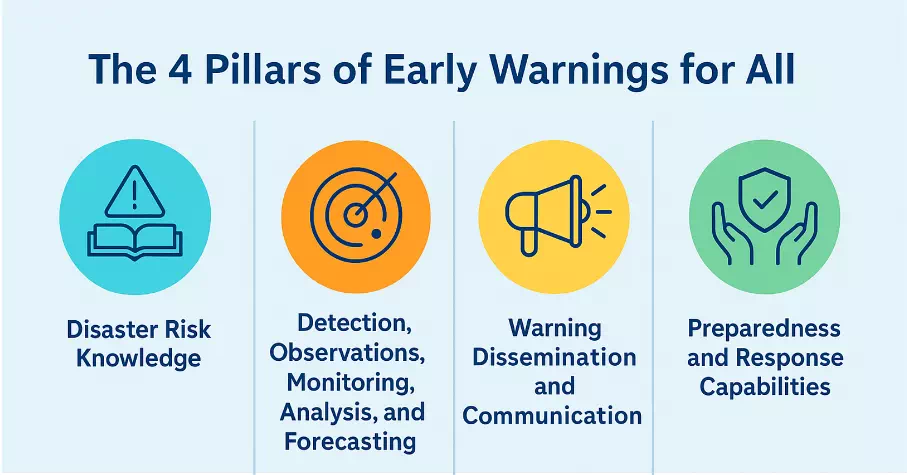
Blog
When Every Minute—and Every Euro—Matters
3rd of September 2025

Figure 1. The EW4All four pillars of end-to-end, people-centred early warning systems and their flow from hazard monitoring to community response. By “early warning system” we mean an end-to-end, people-centred chain that turns risk information into action. It has four interconnected elements: (1) disaster risk knowledge; (2) detection, observation, monitoring, analysis and forecasting; (3) warning dissemination and communication; and (4) preparedness and response capabilities.
In 2024, Europe witnessed once again how climate extremes transcend borders—and budgets. Torrential rains in Spain triggered floods that swept into southern France. Wildfires in the Mediterranean affected air quality as far north as Germany. Heatwaves forced energy grid shutdowns and disrupted agriculture in multiple EU countries simultaneously. These events are part of a growing pattern of climate-related disasters with increasingly transboundary and economic impacts.
The Early Warnings for All (EW4All) initiative, launched by the UN Secretary-General in 2022, aims to ensure that every person on Earth is protected by life-saving early warning systems by 2027 (Figure 1). It’s a bold goal—one grounded in solid evidence. Countries with comprehensive early warning systems experience six times lower disaster mortality and 2.6 times fewer people affected compared to countries with limited systems, according to the Sendai Framework Monitor.
But beyond lives saved, there’s a compelling economic case to be made. In 2024 alone, 93% of financial losses from disasters were weather-related. Tropical cyclones alone cost the world $135 billion. In Europe, the increasing frequency of extreme weather—floods, droughts, heatwaves—is disrupting everything from transport networks to supply chains, with cascading economic consequences.
Investing in early warning systems is not just about resilience; it’s a strategic economic decision. The Global Commission on Adaptation estimates that every $1 invested in early warning saves up to $10 in avoided losses. And when disasters hit multiple countries at once—as they often do in Europe—a shared approach becomes a financial necessity.
Europe’s geography and interconnected infrastructure make it especially vulnerable to transboundary climate impacts. Rivers like the Danube or the Rhine don’t stop at national boundaries. Neither do wildfire smoke, drought conditions, or supply chain disruptions from weather events.
Yet early warning systems in Europe are still predominantly managed at the national level. Coordination exists, but it is fragmented and inconsistent—especially when it comes to data sharing, risk assessment, and public communication.
Climate shocks outside Europe routinely reverberate into the EU economy and society—for example, El Niño-linked drought restricting Panama Canal transits disrupted supply chains in 2023–2024; heat and irregular rains in West Africa drove cocoa shortfalls and record price spikes that raised confectionery costs; and recurring Saharan dust intrusions degrade air quality and, during events, dampen solar generation output—underscoring the need for shared risk information and coordinated, cross-border early action.
Transboundary risk demands transboundary solutions. Shared vulnerability calls for shared accountability.
A Role for PIISA
The PIISA project is helping to lay the groundwork for more coordinated, integrated responses. By strengthening climate intelligence and promoting data-driven decision-making, PIISA supports a shift toward anticipatory governance. By “climate intelligence” we mean the capability to turn climate and weather data—historical trends, seasonal outlooks, real-time forecasts and impact models—into decision-ready insights for governments, operators and businesses. This includes improving how we measure and share risk, how we build early warning systems that span multiple hazards—and how we fund them.
Europe must lead in this transformation—not just because it can afford to, but because it cannot afford not to. The message is clear: climate risks are accelerating, and their costs are growing. But so too is our capacity to forecast, warn, and act—if we invest wisely and act collectively.
We must treat early warnings not as a humanitarian gesture but as a public good and a strategic economic asset. In a region where so much is shared—from airspace to energy grids—early warning must be too. Because in a world on edge, every minute saved can mean millions saved.
Authors
- Roberta Boscolo, World Meteorological Organization (WMO)